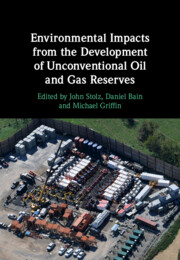Book contents
- Environmental Impacts from the Development of Unconventional Oil and Gas Reserves
- Environmental Impacts from the Development of Unconventional Oil and Gas Reserves
- Copyright page
- Contents
- Figures
- Tables
- Contributors
- Preface
- Part I Overview
- Part II Environmental Analysis
- Part III Case Studies
- 13 Evaluation of Potential Water Quality Impacts in Unconventional Oil and Gas Extraction
- 14 A Baseline Ecological Study of Tributaries in the Tenmile Creek Watershed, Southwest Pennsylvania
- 15 The Effects of Shale Gas Development on Forest Landscapes and Ecosystems in the Appalachian Basin
- 16 Managing TDS and Sulfate in the Monongahela River
- Index
- References
16 - Managing TDS and Sulfate in the Monongahela River
Three Rivers QUEST
from Part III - Case Studies
Published online by Cambridge University Press: 28 July 2022
- Environmental Impacts from the Development of Unconventional Oil and Gas Reserves
- Environmental Impacts from the Development of Unconventional Oil and Gas Reserves
- Copyright page
- Contents
- Figures
- Tables
- Contributors
- Preface
- Part I Overview
- Part II Environmental Analysis
- Part III Case Studies
- 13 Evaluation of Potential Water Quality Impacts in Unconventional Oil and Gas Extraction
- 14 A Baseline Ecological Study of Tributaries in the Tenmile Creek Watershed, Southwest Pennsylvania
- 15 The Effects of Shale Gas Development on Forest Landscapes and Ecosystems in the Appalachian Basin
- 16 Managing TDS and Sulfate in the Monongahela River
- Index
- References
Summary
In late 2008 increasingly high concentrations of total dissolved solids (TDS) exceeding Federal Safe Drinking Water Act (SDWA/PL 93-523) standards of 500 milligrams per liter (mg/L) for public water supplies were found in the Monongahela River. The Pennsylvania Department of Environmental Protection (PA DEP) began investigating TDS levels at points along approximately 70 stream miles on the Monongahela River from the West Virginia border to the confluence with the Youghiogheny River. In response, the West Virginia Water Research Institute (WVWRI) spearheaded a long-term water quality monitoring program in the Monongahela River Basin to identify sources and potential remediation options. The team found that modulation of the discharge volume from acid mine drainage treatment plants along the river could control TDS and sulfate levels below SDWA limits. Operators of the AMD treatment plants implemented the newly developed discharge management plan. The monitoring program expanded in 2012 to include the Allegheny and Upper Ohio River basins, adopting the name Three Rivers Quest (3RQ).
Keywords
- Type
- Chapter
- Information
- Publisher: Cambridge University PressPrint publication year: 2022



